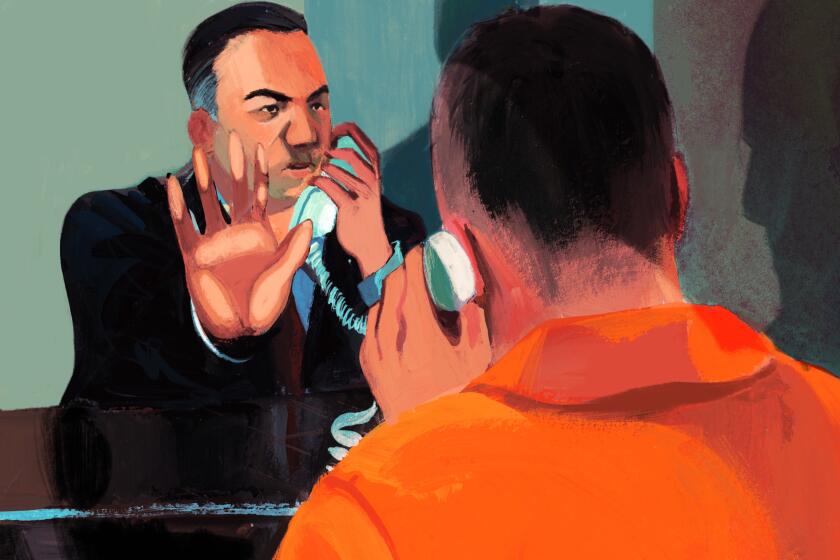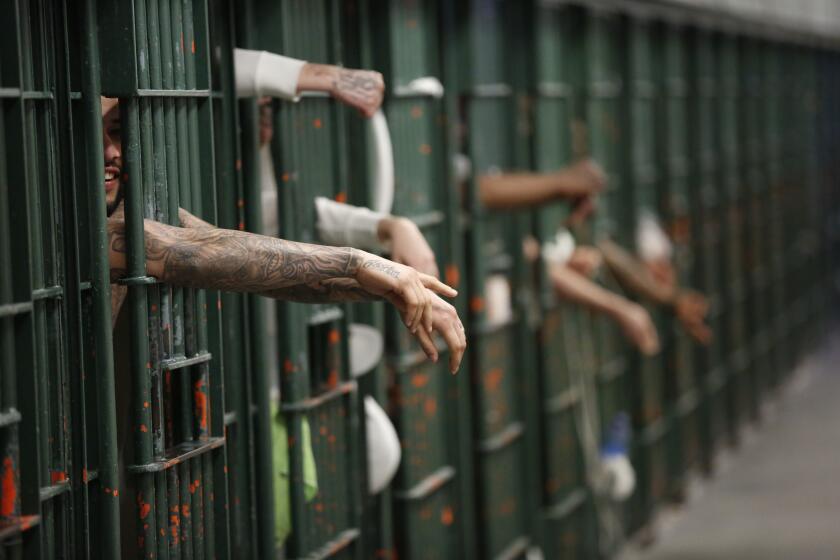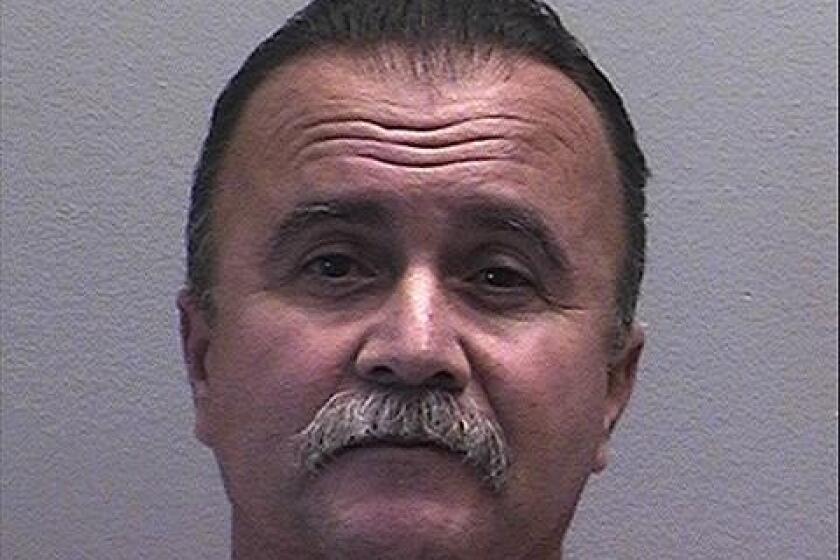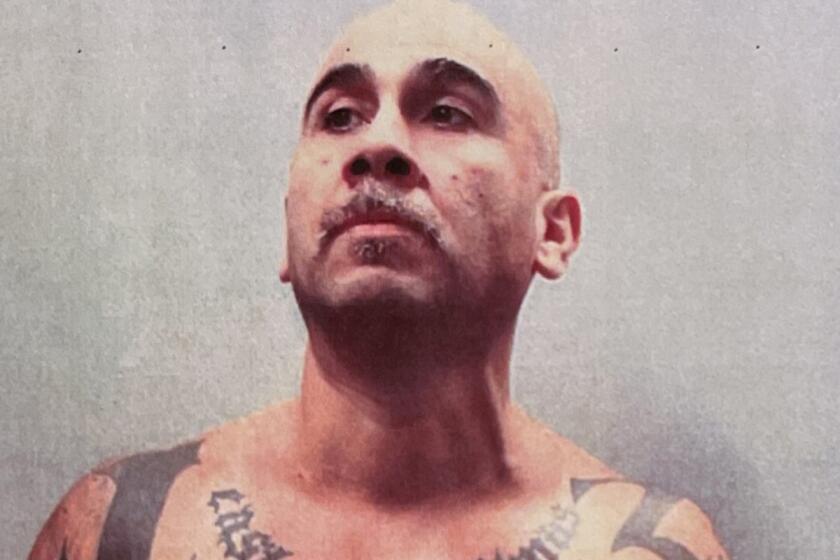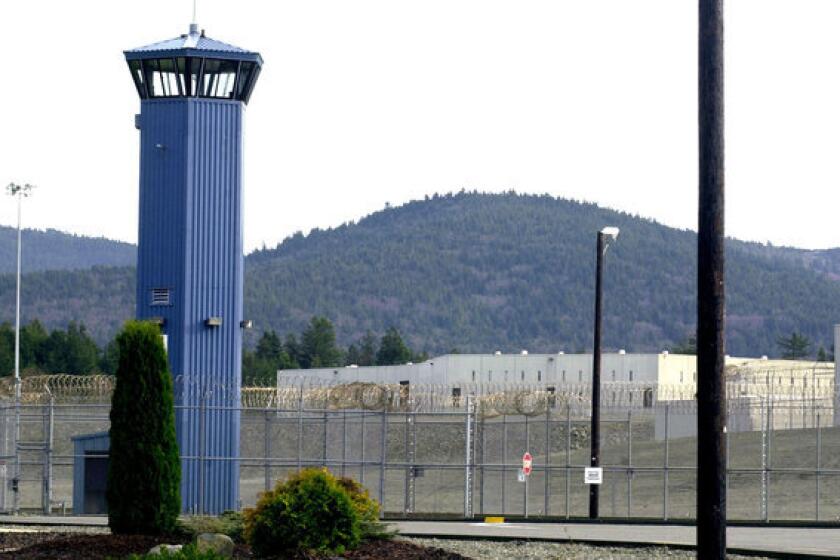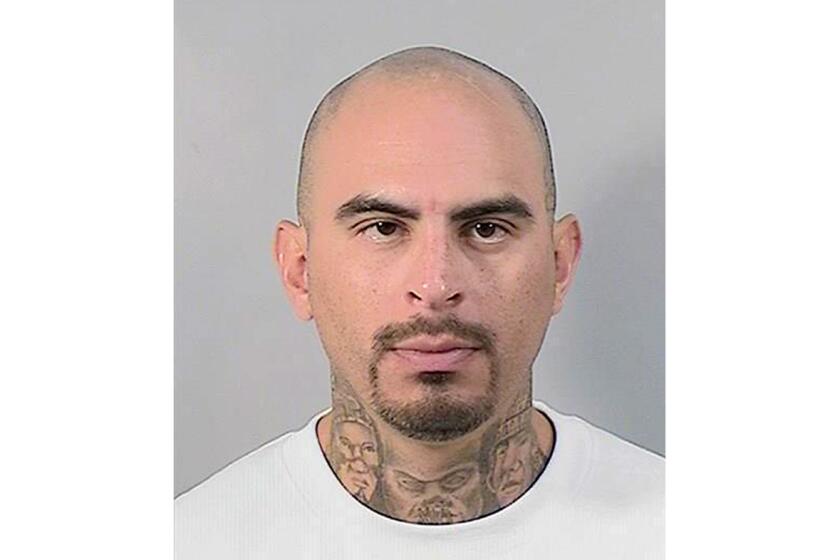The Mexican Mafia, a hit list, a swallowed note: Lawyer charged in murder plot
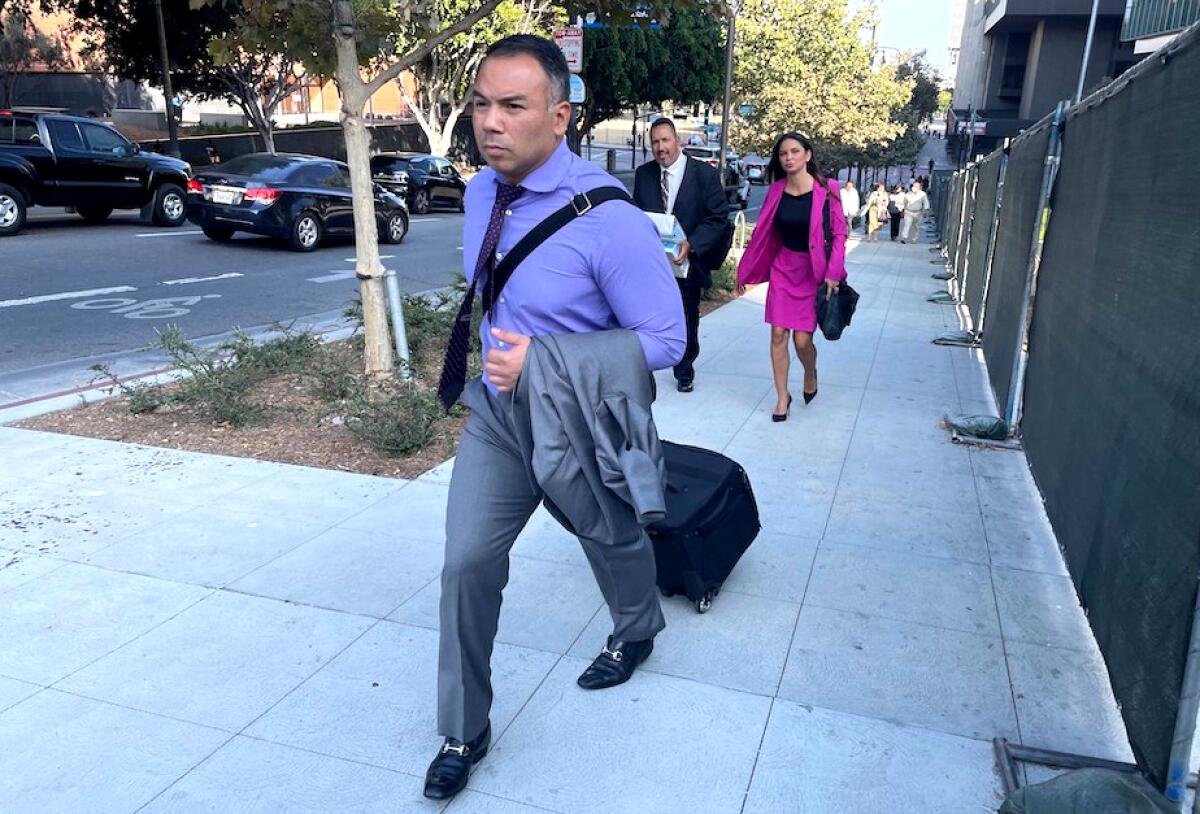
- Share via
A criminal defense attorney was charged in a federal indictment unsealed last week with conspiring to murder a member of the Mexican Mafia who had fallen out of favor with the prison-based syndicate.
Gabriel Zendejas Chavez was first indicted in 2018, accused of using the confidentiality afforded by his bar license to relay messages between Mexican Mafia members held in far-flung prisons. Witnesses have testified that he helped the organization traffic drugs, collect extortion proceeds and unmask government informants.
Federal prosecutors say Gabriel Zendejas Chavez, a criminal defense attorney who once taught English, connected the Mexican Mafia’s bases of power in prisons, jails and the streets of Southern California.
Chavez, who taught English at high schools in Pomona while studying to become a lawyer at night, has maintained his innocence. At his trial in federal court in 2022, he testified that after he won a longtime Mexican Mafia member’s release from prison in 2013, other inmates sought his representation.
Records showed Chavez conferred with dozens of Mexican Mafia members at the high-security state prison at Pelican Bay, the federal “supermax” facility in Florence, Colo., and other institutions designed to isolate gang leaders. Chavez testified he only pretended to help imprisoned gang members after one of them threatened his young daughter, telling the jury tearfully: “There’s no manual for this situation.”
Until his murder in prison two weeks ago, Michael Torres ran one of the most intricate and lucrative black market businesses in L.A. County: the jails.
After the panel failed to reach a verdict on racketeering and drug distribution charges, the judge declared a mistrial. Prosecutors vowed to retry Chavez.
In the superseding indictment returned last week, prosecutors implicated Chavez in the homicide of DMM-6, short for “Deceased Mexican Mafia Member 6.” Details within the indictment and testimony at Chavez’s trial make clear the victim is Frank Munoz, a Mexican Mafia member nicknamed “Little Man.”
Chavez’s attorney, Meghan Blanco, said she would ask a judge to dismiss the new indictment, which she called “a crazy, last-minute move on the government’s part.”
Blanco said after prosecutors failed to get a guilty verdict with witnesses “whose information is clearly false,” they recruited new informants who are “worse liars than the first batch.” Chavez denies having any role in the conspiracy to kill Munoz and would push for a trial this summer, she said.
Released from federal prison in 2013 after serving 23 years for bank robbery, Munoz returned to his old neighborhood on the west side of Wilmington to find it claimed by Mexican Mafia members held in the state prison system, a witness testified at Chavez’s trial.
“Sleepy and Tonito were old members,” the witness told the jury, referring to Gabriel “Sleepy” Huerta and Emiliano “Tonito” Lopez, who were both serving life terms for murder. “They’ve been controlling Wilmington for over a decade.”
Gabriel ‘Sleepy’ Huerta is an alleged member of the Mexican Mafia’s three-man ‘commission.’ He’s been charged in a more mundane matter: the beating of a Wilmington gang member who lost a gun.
With Munoz trying to collect money in the harbor area, the witness said, Huerta and Lopez sent him a message through Chavez: “Slow your roll.”
Huerta, a reputed member of the Mexican Mafia’s three-man governing “commission,” was charged late last year with overseeing the Eastside Wilmas gang. The 64-year-old, who has been imprisoned since 1984, has pleaded not guilty to directing drug deals and ordering an assault on the streets of Wilmington. Lopez was stabbed to death at Calipatria State Prison in 2016.
Munoz had modest ambitions for a Mexican Mafia member. Hobbled by knee surgeries that he’d undergone in prison, a witness told detectives in an interview reviewed by The Times, Munoz was content to sell small amounts of methamphetamine and collect a few hundred dollars here and there from gang members working on his behalf.
In an indictment unsealed after his death, federal prosecutors accused Munoz of collecting a “tax” from pushers who sold drugs in motels, bars and parking lots in Wilmington. In one call cited by prosecutors, Munoz discussed the packaging of six ounces of meth, which he said he would pick up himself.
After a jailed member of the Northside Longo gang told the authorities that Munoz was trying to stake a claim in Long Beach, Munoz was caught on a recorded line ordering the man’s beating and a $500 fine.
The syndicate once relied on associates on the streets, but court data showed that smuggled phones have given imprisoned leaders greater control over drug deals.
“All I wanted was someone that will smack this motherf— upside the head a couple of times just to let him know to keep his f— mouth shut,” Munoz told an inmate in the Los Angeles County jail, according to court records.
“Consider it done,” the inmate said. Sheriff’s deputies moved the target into protective custody before he was harmed.
By then, Munoz found himself in the middle of a bitter feud playing out on prison yards and the streets of Los Angeles between Mexican Mafia members who served time in the federal and state prison systems.
After getting out of federal prison in 2014, Dominick “Solo” Gonzales began collecting money from gangs and dealers in the San Fernando Valley, angering Mexican Mafia members in the California system whose grip over the area had gone unchallenged for years, witnesses testified at a federal racketeering trial.
Gonzales was making up for lost time. He’d served 15 years, and felt the Mexican Mafia members in the California system had disrespected his stepfather, Frank “Sapo” Fernandez, by cutting him out of the San Fernando Valley rackets after he was sent to federal prison for life in 2000.
Gonzales also clashed with Pete “Malo” Cordero, the nephew of a Mexican Mafia member. After Cordero was gunned down in late 2015, Gonzales was blamed. Mexican Mafia members held a 30-man conference call, dialing in from various state prisons on contraband cellphones, a witness testified. The consensus: Gonzales had to go.
The task fell to Cordero’s best friend, Jose “Cartune” Loza, according to evidence presented at Loza’s trial in 2019. After setting up a meeting with Gonzales at El Jalisco Cafe in Bassett in the San Gabriel Valley, Loza asked Munoz to accompany him, a witness testified. Munoz refused, citing his bad knees.
Jose Luis Loza of Whittier is sentenced after a trial that served as a window into arguably Southern California’s most powerful criminal organization.
Loza shot Gonzales to death at the restaurant, and is now serving a sentence of life plus 30 years in federal prison.
After Gonzales’ death, Munoz was placed on “the lista” — the Mexican Mafia’s hit list, according to witnesses who testified against Loza and Chavez.
Chavez represented Raul “Cool Cat” Rocha, who in 2016 was petitioning to overturn a 25-years-to-life sentence for his third strike — stealing a pair of pants in 1995. While being held in Los Angeles County jail, Rocha testified that another inmate, Robert “Dopey” Hinojos, asked that he bring a note inquiring about Gonzales and Munoz to the legal visiting room. Rocha testified that Chavez confirmed both men were marked for death before swallowing the note.
Chavez denied passing word of any hit list, telling the jury: “I did not, and would not, ever harm someone.”
Around 4 p.m. on Oct. 1, 2016, Munoz was standing outside his fiancee’s home in Hawaiian Gardens when a gunman shot him 13 times, according to a coroner’s report. The indictment says only that “UICC 58” — unindicted co-conspirator 58 — killed Munoz with the help of two other people.
Robert Hinojos was convicted after a trial that shed light on the workings of the Mexican Mafia, a group of about 140 men who wield enormous influence in prisons and on the streets of Southern California.
Hinojos, a reputed Mexican Mafia member from Paramount’s Brown Nation gang, is now serving two life sentences after being convicted of killing a man in Paramount and conspiring to murder an inmate at Centinela State Prison.
During Hinojos’ trial for the Paramount murder, prosecutors played a tape that was secretly recorded inside a cell block that Hinojos shared with another Mexican Mafia member, Daniel “Danny Boy” Pina.
Explaining that prosecutors had to have “inside knowledge about something” to charge him, Pina whispered to Hinojos: “The good thing is finally you are gonna be able to find out what exactly them bastards have.”
“Hopefully there is no, no, no — uh, the thing with Little Man,” Hinojos said, a reference to Munoz’s nickname.
Pina shushed him. “Don’t say anything about that to anybody,” he said.
More to Read
Sign up for Essential California
The most important California stories and recommendations in your inbox every morning.
You may occasionally receive promotional content from the Los Angeles Times.
